
Exhibition
Tala Madani: Shitty Disco
05 Oct 2016 – 11 Nov 2016
Pilar Corrias
Mixing their rich and sophisticated cultural heritage with fresh, multi-disciplinary practices, contemporary Iranian artists play a major role in challenging the common perception of Iranian art and culture.
Our guest editor Tara Aghdashloo picked nine talents you should check out:
Bita’s (b. 1962, Tehran, Iran) works are not pretty, and they will not please the eye. The are often sculptures depicting death (of dogs, of unborn babies) and gruesome imagery (cockroaches, black crows hanging around like death). But they please me, because they are full of life. She gives form to the morbid, to the unwanted creatures that we scold and run away from, and in that creation she makes them immortal. There is a sense of hope, even justice in that. Bita’s work is the revenge of the misfits, and who doesn’t love that.

Bita Fayyazi, Cockroaches, installation of 2000 ceramics each 15cm in length at Nikolaj Contemporary Art Center Copenhagen, 1998. Courtesy the artist.
Tala Madani’s (b. 1981, Tehran, Iran) work immediately thrilled me when I first came upon it. The clean blocks of colours that are smudged onto each other at the right angle, the cartoon-like male characters who tell a simple yet cut-throat story in each frame - I liked her work before I even knew she’s Iranian. Her work seems childishly simple, but there’s a deep psychology behind it which allows the viewer to revel in the piece whilst peeling its subtext. Her education and background in political science may have helped shape her unique criticism (in, for example, subverting the male gaze), but what grips me the most is the ease of narrative and playfulness of her palette.
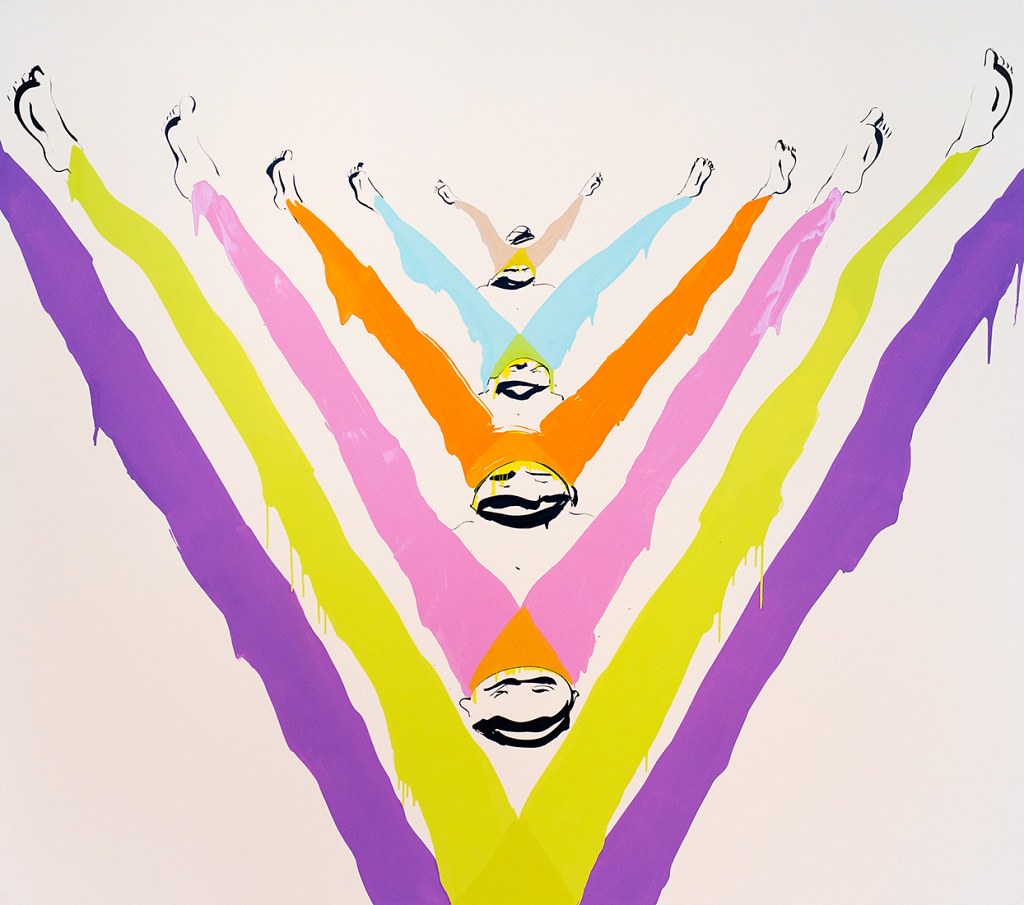
Tala Madani, Morris Men with Piss Stain, 2013, oil on linen, 193 x 218.5 cm.
Parastou (b. 1962, Tehran, Iran) has been an influential installation artist for years now. Her artistic mind space is dark and political, not least because of the personal experience she’s had with the injustices of the totalitarian, bureaucratically unjust system in post-revolutionary Iran. Yet there is a poetry, a grandiosity in her pieces that take the viewers/participants well beyond the very real world of politics and society, into the realm of dreams and wishful thinking. She’s experimented with different styles and mediums (photography, design, calligraphic-art), and a lot of her motifs are familiar of Iranian artists but Forouhar’s harmonious execution of these themes in unthreatening yet morbid aesthetic is a feast for the eyes.
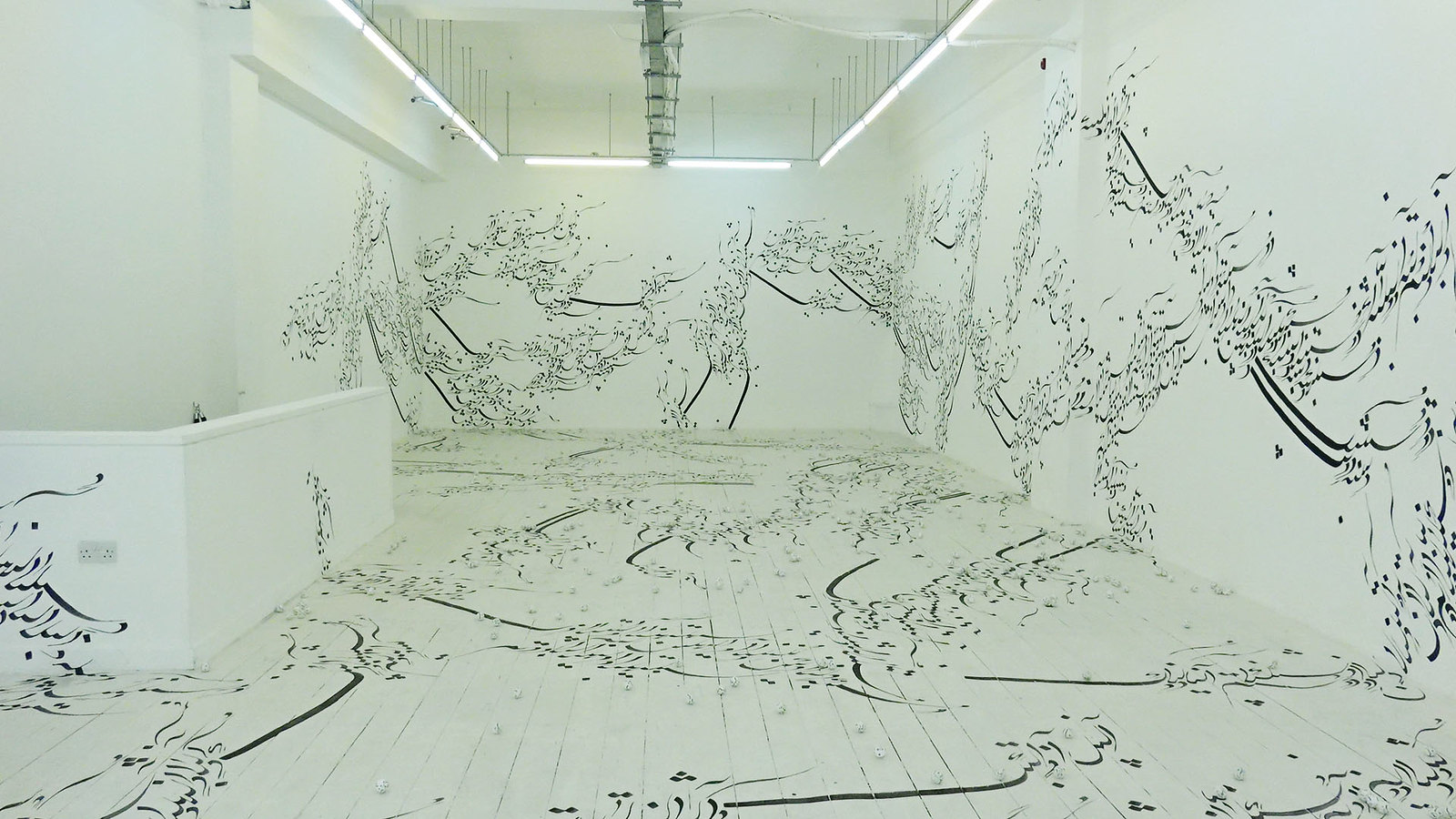
Parastou Forouhar, Written Room, 2016, installation view from Pi Artworks London.
Filizadeh (b. 1970, Tehran, Iran) is another artist working in large sizes (like Forouhar installations), who masterfully curates people in photographic collages or paintings and sculptures, reflecting the contemporary Iranian society. By now, many young Iranian artists are using historic iconographies (from geometric Islamic designs to the fashions of the Qajar dynasty or the Pahlavi era pop culture), subverting them into a critique of Persian/Iranian identity. Some do the practice less elegantly, and more for a foreign gaze who will no doubt fetishise what they don’t know about the Iranian past. But Filizadeh approaches the subject with a sense of humour and defiance. What I also like about him is him taking risks in every new series, challenging himself both in the medium and the message.
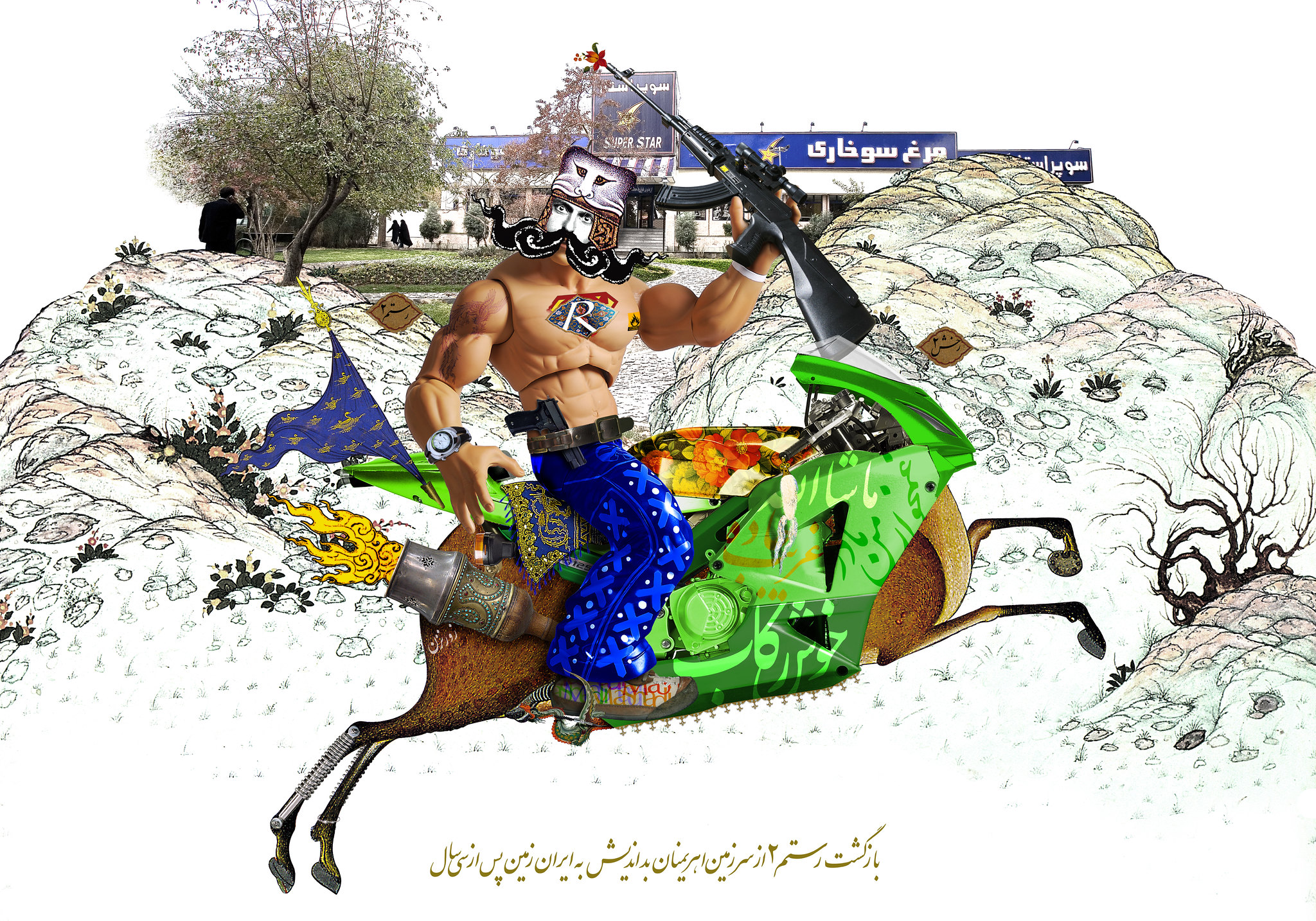
Siamak Filizadeh, Return of Rostam to Iran, 2009, Digital print, 140x200 cm. Courtesy the artist and Aaran Gallery.
Bahareh’s (b. 1985, Tehran, Iran) portraits are hauntingly beautiful. She has a mostly monochromatic palette of black and white with the occasional colourful object, creating a cold emotional visage. The simplicity of her work makes you curious about what she’s holding back, deducting from the final frame — and here I will use the ever overused and misused cliche word in describing Middle Eastern art — as in a veil. There is no veil, no contrived mystery or implicit political message. Instead, her characters are often in a black cocoon-like mass, distinguished (or restrained) from the white background. I like her stories and I like her consistency.
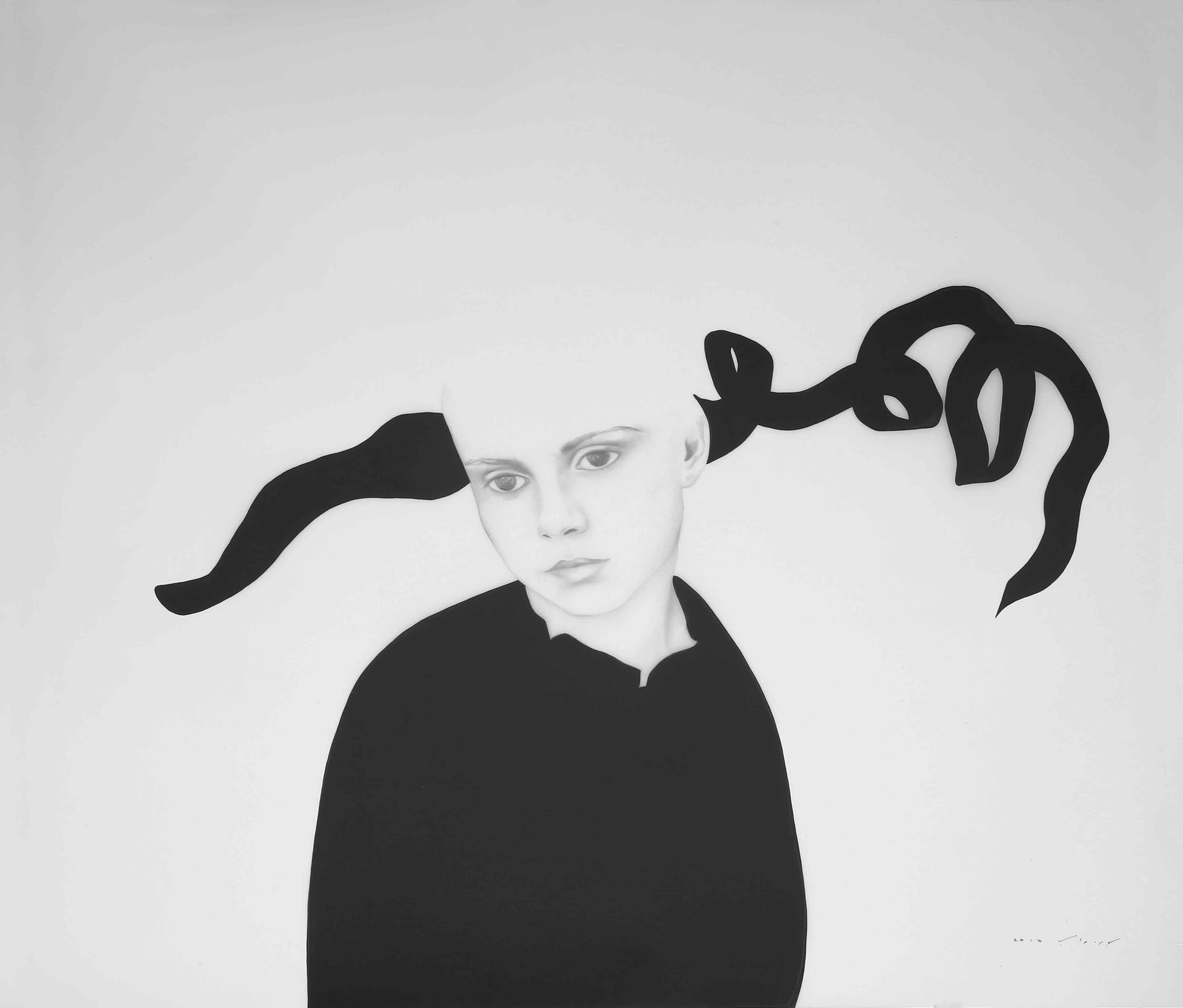
Bahareh Navabi, Untitled, Work on paper.
Site-specific works are both an act of the ego (a grand statement that finds only this space worthy of reckoning), and also completely humble (and then it wasn’t there). Akhavan’s works, from performance to video art and grand installations, come from a curious and playful mind that sees art everywhere. In some pieces he revives memories of his past, some of which are familiar to people who share the same culture, growing up with the same trivial objects and transient landscapes. But often he is an extremely ‘present’ mind commenting on his surrounding environment and society.

Abbas Akhavan, Fatigues, 2014, Taxidermy animals, temporary tattoos. Courtesy the artist.
If you like the weird and the uncanny, as I do, you will love Mohammad-Hossein Gholamzadeh’s figures of old men doing odd things. The point of being an artist, in my opinion, is to do just that: play around, juxtapoze, materialize the creatures nestling in the corners of your imagination. And what an imagination Gholamzadeh has, both coy and terrifying. In the Mirror series, he made detailed sculptures of old men, dirty and lazy yet sometimes flying sometimes idly sitting, and seem to be a study not just in the human body but its capacity to speak.
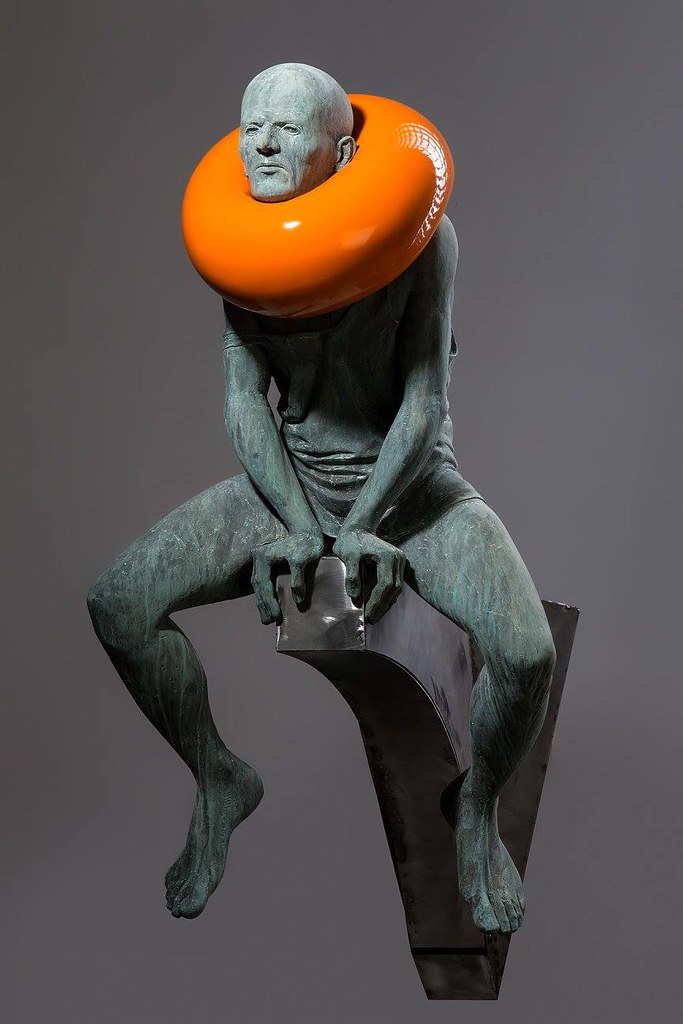
Mohammad-Hoseein Gholamzadeh, Drowning, 2016. Courtesy the artist.
Here’s another great use of an Iranian icon: the Peykan. Iran’s “national chariot” since the 60s when it was created, representing a foregone glory and pride that is now a liability both for the environment and the drivers who ride them; mostly as taxis. Still, you can’t imagine the smoggy streets of Tehran without them. By juxtaposing the old cars with wild animals in different urban scenes, Adel Hosseini-nik's ultra-realistic and skilfull paintings are instantly contemporary and classic.
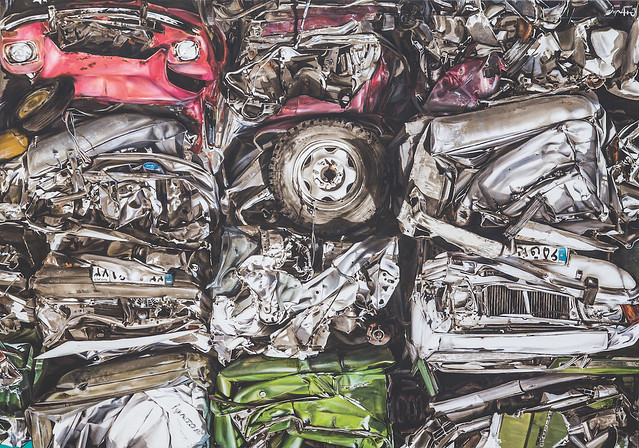
Adel Hosseini-Nik, painting, 2011. Courtesy the artist and Shirin Gallery Tehran.
I'm not putting her on this list because she's a beautiful person and a friend. She's on the list because I've seen the progression of her work, as the line between her person and her art slowly diminishes. Keyhani's paintings and more recently her sculptures are a pale palette of mishaps — they are as if from a cabinet of curiosities, works that she calls materialisation of her own anxieties. The works are faceless but defiant, and their maker is committed to them as if they are her children. She recently had a solo show in Dubai.

Maryam Keyhani, Pink Ribs, Epoxy, plaster, paint, hand-made brush. Courtesy the artist.
Tara Aghdashloo is a writer, filmmaker and curator. She often chooses art as a subject to write or make documentaries about. Tara was born in Tehran, Iran, and she lived in Toronto, Canada before moving to London, UK. She's interested in critical theory, politics, sake, feminism, and a good story. Find her on Twitter and Instagram.
For more updates on contemporary art and exhibitions follow ArtRabbit on Twitter, Facebook or Instagram, or subscribe to our Newsletter.
And receive more editorial like this directly to your inbox.
Beyond the Biennale - A Guide to Must-See Art Exhibitions in Venice, 24 Apr 2024
News: ArtRabbit and Great Western Railway (GWR) Launch New Initiative to Promote Art-Focused Rail Journeys across the South West, West, and South Wales, 24 Apr 2024
Bristol Beyond the Streets: World Class Contemporary Art and Family Friendly Events, 24 Apr 2024
LA Spotlight: Ville Kansanen at Marshall Gallery, 17 Apr 2024
The City Lit Fine Art Course. A look inside an alternative Fine Art programme, 16 Apr 2024
Witnessing Change: UK Exhibitions on Climate, Ecology & Political Upheaval, 10 Apr 2024
NY Spotlight: Käthe Kollwitz at MoMA, 27 Mar 2024
LA Spotlight: Rachel Lachowicz at Shoshana Wayne Gallery, 27 Mar 2024
Lates - A Night at the Museum: Our Favourite Late Night Openings, 26 Mar 2024
LA Spotlight: Lucia Engstrom at Von Lintel Gallery, 20 Mar 2024
Read more editorial